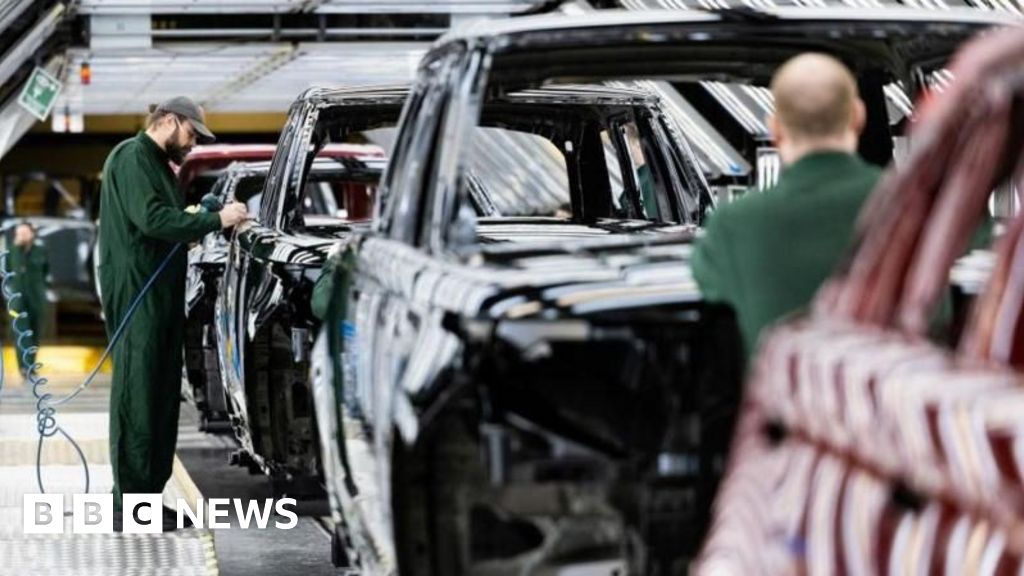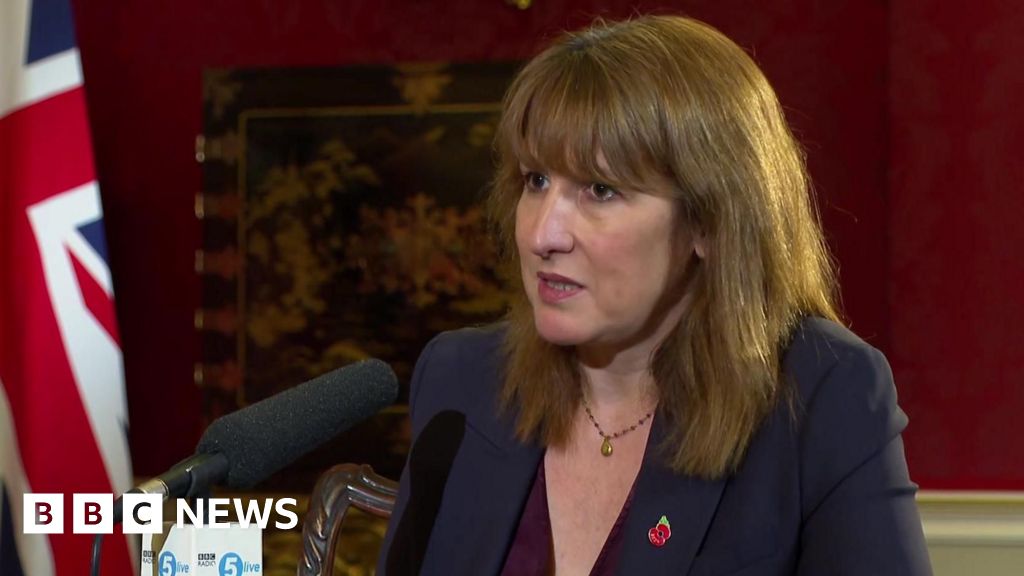Business
JLR begins ‘phased restart’ of operations

Michael RaceBusiness reporter, BBC News
 Getty Images
Getty ImagesJaguar Land Rover (JLR) says it has begun a “phased restart” of its operations with parts of its IT system back up and running.
The company said it was “working to clear a backlog of payments” to suppliers as it now had increased its processing capacity for invoicing.
The carmaker’s production lines have been suspended since a cyber attack in August forced the company to shut down its IT networks. Its factories remain closed until next month at the earliest.
The government is considering stepping in to support JLR’s parts suppliers, with concerns growing that some, mostly small businesses, could go bust due to the prolonged shutdown of operations.
JLR said on Thursday that its recovery programme was “firmly under way” and that its global parts logistics centre, which supplies spare parts that service customers’ vehicles, “returning to full operations”.
“The financial system we use to process the wholesales of vehicles has been brought back online and we are able to sell and register vehicles for our clients faster, delivering important cash flow,” the company added.
The carmaker said it recognised that the situation was a “difficult time for all connected with JLR”, with no new cars being built and staff being sent home from work.
The manufacturer, which is owned by India’s Tata Motors, typically builds about 1,000 cars a day at its three factories in Solihull and Wolverhampton in West Midlands, and Halewood in Merseyside.
Workers have been told to stay home since 1 September, with no firm return date.
About 30,000 people are directly employed at the company’s plants with about 100,000 working for firms in the supply chain. Some of these firms supply parts exclusively to JLR, while others sell components to other carmakers as well.
Calls have been made to support suppliers, whose businesses are under threat as a result of the knock-on impact of the cyber attack.
One idea being explored is the government buying the component parts the suppliers build, with the aim of keeping the companies in JLR’s supply chain in business until production lines are up and running again.
However, firms have told the BBC they are sceptical about the success of such a scheme.
The government “simply don’t understand the complexity of what they’re dealing with”, said one supplier.
“We don’t need promises, we need help.”
Unions have called for a Covid-style furlough scheme, but ministers have ruled this out given its likely cost, sources have told the BBC.
While the purchase and stockpiling of car parts by the government is an option on the table, this would present considerable logistical challenges.
JLR’s manufacturing process relies on the right part arriving at the right place, at the right time.
Another option being considered is government-backed loans to suppliers, though this is understood to be unpopular with suppliers.
Business
Full list of Morrisons cafe and store closures revealed

Morrisons has said it will shut 52 of its in-store cafes along with some of its convenience stores, florists, meat and fish counters and pharmacies.
Eighteen market kitchens, 17 convenience stores, 13 florists, 35 meat counters, 35 fish counters and four pharmacies will also be affected.
The supermarket said the closures are part of a shake-up which will result in 365 people facing redundancy.
Full Morrisons store closure list
Cafes
Bradford Thornbury – West Yorkshire
Paisley Falside Rd – Renfrewshire, Scotland
London Queensbury – Greater London
Portsmouth – Hampshire
Great Park – Tyne and Wear
Banchory North Deeside Rd – Aberdeenshire, Scotland
Failsworth Poplar Street – Greater Manchester
Blackburn Railway Road – Lancashire
Leeds Swinnow Rd – West Yorkshire
London Wood Green – Greater London
Kirkham Poulton St – Lancashire
Lutterworth Bitteswell Rd – Leicestershire
Stirchley – West Midlands
Leeds Horsforth – West Yorkshire
London Erith – Greater London
Crowborough – East Sussex
Bellshill John St – North Lanarkshire, Scotland
Dumbarton Glasgow Rd – West Dunbartonshire, Scotland
East Kilbride Lindsayfield – South Lanarkshire, Scotland
East Kilbride Stewartfield – South Lanarkshire, Scotland
Glasgow Newlands – Glasgow, Scotland
Largs Irvine Rd – North Ayrshire, Scotland
Troon Academy St – South Ayrshire, Scotland
Wishaw Kirk Rd – North Lanarkshire, Scotland
Newcastle upon Tyne Cowgate – Tyne and Wear
Northampton Kettering Road – Northamptonshire
Bromsgrove Buntsford Ind Pk – Worcestershire
Solihull Warwick Rd – West Midlands
Brecon Free St – Powys, Wales
Caernarfon North Rd – Gwynedd, Wales
Hadleigh – Suffolk
Harrow, Hatch End – Greater London
High Wycombe Temple End – Buckinghamshire
Leighton Buzzard Lake St – Bedfordshire
London Stratford – Greater London
Sidcup Westwood Lane – Greater London
Welwyn Garden City Black Fan Rd – Hertfordshire
Warminster Weymouth St – Wiltshire
Oxted Station Yard – Surrey
Reigate Bell St – Surrey
Borehamwood – Hertfordshire
Weybridge, Monument Hill – Surrey
Bathgate – West Lothian, Scotland
Erskine Bridgewater SC – Renfrewshire, Scotland
Gorleston Blackwell Road – Norfolk
Connah’s Quay – Flintshire, Wales
Mansfield Woodhouse – Nottinghamshire
Elland – West Yorkshire
Gloucester – Metz Way – Gloucestershire
Watford – Ascot Road – Hertfordshire
Littlehampton – Wick – West Sussex
Helensburgh – Argyll and Bute, Scotland
Morrisons Daily convenience stores
Gorleston Lowestoft Road – Norfolk
Peebles 3-5 Old Town – Scottish Borders, Scotland
Shenfield 214 Hutton Road – Essex
Poole Waterloo Estate – Dorset
Tonbridge Higham Lane Est – Kent
Romsey The Cornmarket – Hampshire
Stewarton Lainshaw Street – East Ayrshire, Scotland
Selsdon Featherbed Lane – Greater London
Haxby Village – North Yorkshire
Great Barr Queslett Rd – West Midlands
Whickham Oakfield Road – Tyne and Wear
Worle – Somerset
Goring-By-Sea Strand Parade – West Sussex
Woking Westfield Road – Surrey
Wokingham 40 Peach Street – Berkshire
Exeter 51 Sidwell Street – Devon
Bath Moorland Road – Somerset
Business
Rachel Reeves suggests family benefit limits will be lifted

Paul SeddonPolitical reporter
Rachel Reeves has suggested she favours removing limits on benefits linked to family size at this month’s Budget.
The chancellor told the BBC it was not right that children in bigger families were “penalised” through “no fault of their own”.
The comments are a sign she could remove the two-child limit on working-age benefits introduced under the Conservatives in 2017.
Some Labour MPs have been calling for a full reversal of the policy, amid reports she was considering paring back payments after two children instead.
In September, the Guardian reported that Treasury officials were considering a tapered approach, under which parents would receive most benefits for their first child and less for subsequent children.
Other options under consideration included limiting additional benefits to three or four children, the newspaper reported.
But speaking to Matt Chorley on BBC Radio 5 Live, Reeves suggested she did not want to see benefits limited according to family size.
“I don’t think that it’s right that a child is penalised because they are in a bigger family, through no fault of their own,” she added.
“And so we will take action on child poverty. The last Labour government proudly reduced child poverty, and we will reduce child poverty as well.”
She added there were “plenty of reasons why” parents who decided to have three or four children could see their financial circumstances change.
Manifesto pledges
Elsewhere in her interview, she all but confirmed the government plans to break Labour’s manifesto pledge at last year’s general election not to raise income tax rates, VAT or National Insurance.
“It would of course be possible to stick with the manifesto commitments. But that would require things like deep cuts in capital spending,” she added.
“What I can promise now is I will always do what I think is right for our country. Not the politically easy choice, but the things that I think are necessary to put our country on the right path,” she added.
Labour’s 2024 election manifesto pledged not to raise the basic, higher, or additional rates of income tax, or National Insurance – prompting a row last autumn when Reeves announced a hike in the contributions paid by employers.
It also promised not to raise Value Added Tax (VAT), a sales tax, although the manifesto did not specify whether this applied to the rates, or which products are subject to the charge.
The chancellor has not ruled out continuing to freeze income tax thresholds beyond the 2028 date fixed by the last government, allowing more people to be dragged into higher bands as their wages rise over time.
Pressed on whether she could have avoided tax hikes through lower public spending, she said she was “not going to apologise” for increased funding for the NHS, adding that reducing waiting lists was one of her three Budget priorities.
She also claimed that some of the spending she unveiled at June’s spending review had been pencilled in, but not properly funded, by the Tories.
‘Same choices’
The two-child cap prevents households on universal or child tax credit from receiving payments for a third or subsequent child born after April 2017.
This is different to child benefit, which is paid to families where the highest-earning parent earns less than £80,000.
Separately, there is also an overall cap on the amount of benefits working-age families can claim, which has been in place since 2013.
The Institute for Fiscal Studies think tank estimates fully reversing the two-child benefit cap could take 630,000 children out of absolute poverty, defined as households with an income below 60% median average, at a cost of £3.6bn a year.
Pressure to ditch the limit increased during the recent Labour deputy leadership contest, where successful candidate Lucy Powell and runner-up Bridget Phillipson both indicated they favoured more action on child poverty.
Reform UK is pledging to scrap the limit for working British couples if it wins power, although the Conservatives say the cap should remain in place, forcing a symbolic vote on the issue in the House of Commons in September.
Speaking after the vote, Tory leader said her party believes “those on welfare should have to make the same choices as those who aren’t,” and Labour and Reform were expecting working people to pay for “unlimited handouts”.

Business
FTSE 100 at new high amid US shutdown optimism

The FTSE 100 hit an all-time best on Monday, passing 9,800 for the first time, as hopes grow for an end to the US government shutdown.
The FTSE 100 Index closed up 104.58 points, 1.1%, at 9,787.15, a record closing peak.
It had earlier set a new intra-day best level of 9,800.35.
The FTSE 250 ended 194.88 points higher, 0.9%, at 21,968.27, and the AIM All-Share climbed 8.07 points, 1.1%, at 757.54.
The risk-on mood came as the US Senate cleared the way for a formal debate on a motion to resume funding to federal agencies.
The Republican-led chamber approved a procedural vote after a handful of Senate Democrats crossed over to permit debate on a measure that could end the longest shutdown in US history.
“The prospect that the longest US government shutdown in history may end in the next few days has bolstered risk appetites,” said Marc Chandler, at Bannockburn Capital Markets.
In European equities on Monday, the CAC 40 in Paris closed up 1.5%, while the DAX 40 in Frankfurt soared 1.7%.
In New York, the Dow Jones Industrial Average was little changed at around the time of the London close.
The S&P 500 index was 0.7% higher, while the Nasdaq Composite advanced 1.3%.
Nvidia rose 3.9% ahead of results next week while Advanced Micro Devices climbed 5.7% ahead of Tuesday’s analyst day at which new financial targets are expected to be unveiled.
Morgan Stanley said the developments mean the government shutdown could end this week.
The bank thinks the first major data print post-shutdown is likely to be the September employment report, with other data on inflation and spending probably taking a further one to two weeks.
“We think the data in-hand by the time of the December Fed meeting will be enough for them to cut,” Morgan Stanley added.
Kathleen Brooks, at XTB, said the end of the US government shutdown “comes at the right time”, just before Thanksgiving.
“This should allow American families to fly all over the country for the holidays and it should mean that supply chains are fully functioning for the biggest shopping weekend of the year,” she observed.
Sterling was quoted at 1.3160 dollars at the time of the London equities close on Monday, lower compared with 1.3166 dollars on Friday.
The euro stood at 1.1554 dollars, down against 1.1582 dollars. Against the yen, the dollar was trading higher at 153.97 yen, compared with 153.07 yen.
The yield on the US 10-year Treasury was at 4.11%, widened from 4.07% on Friday. The yield on the US 30-year Treasury was quoted at 4.70%, stretched from 4.68%.
Back in London, the countdown to the Budget at the end of November continues.
Speaking to the BBC, Chancellor Rachel Reeves said the Budget will be focused on the cost of living, getting government debt down and cutting NHS waiting lists.
Speaking to Radio 5 Live, Ms Reeves would not be drawn on specific measures but said tax and spending decisions will be influenced by a productivity review by the Office for Budget Responsibility and ongoing conflicts and disruptions to trade.
It will be a “difficult” Budget, she said, but one focused on “fairness” and growing the economy.
Diageo rose 5.2% after it appointed former Tesco boss Dave Lewis as its new chief executive.
The London-based owner of Guinness stout and Johnnie Walker whisky said Mr Lewis, who led Tesco from 2014 to 2020, will join Diageo at the start of 2026.
Prior to his time at Tesco, Mr Lewis spent nearly three decades at Marmite owner Unilever, where he earned the moniker “drastic Dave” in recognition of his reputation as a cost cutter and turnaround specialist.
Jefferies analyst Edward Mundy said the appointment “ends the uncertainty over leadership transition and brings a heavyweight leader with extensive CEO experience on both brand building and transformation”.
“Not only does he have extensive CEO experience, strong brand-building capabilities and a keen cost focus, he played an important role in changing the culture and restoring the Tesco brand,” Mr Mundy commented.
Gains in the gold price lifted blue-chips Fresnillo and Endeavour Mining 5.4% and 4.5% respectively, while on the FTSE 250 Hochschild Mining jumped 8.0%.
Gold traded higher at 4,091.42 dollars an ounce on Monday against 4,012.24 dollars on Friday.
Entain rose 3.0% as Investec upgraded to “buy” from “hold”, while British Airways owner IAG rallied 3.7% after Friday’s heavy falls after third-quarter news.
On the FTSE 250, RHI Magnesita jumped 17% as it said performance has improved in the second half of 2025 despite subdued demand conditions.
The Vienna-based refractory products maker said adjusted earnings before interest, tax and amortisation were 136 million euros in the four months to October, significantly ahead of the run-rate in the first half of 2025 and in line with guidance.
In the first six months of 2025, RHI Magnesita reported Ebita of 141 million euros.
JTC fell 4.3% after agreeing a £2.7 billion all-cash takeover by Permira Advisers worth 1,340 pence per share.
RBC Capital Markets said conversations with shareholders suggested that price expectations were higher at 1,450p, “so we think there will be a degree of disappointment”.
“We are not convinced that this is yet a done deal however,” the broker added.
Brent oil was quoted slightly lower at 63.45 dollars a barrel at the time of the London equities close on Monday, from 63.51 dollars late on Friday.
The biggest risers on the FTSE 100 were Fresnillo, up 118 pence at 2,310p, Diageo, up 90p at 1,816.5p, Endeavour Mining, up 134p at 3,142p, Polar Capital Technology Trust, up 20p at 472p and SSE, up 74.5p at 1,943p.
The biggest fallers on the FTSE 100 were London Stock Exchange, down 198p at 9,072p, Rightmove, down 10.2p at 563.4p, Hikma Pharmaceuticals, down 27p at 1,555p, BT, down 2.25p at 177.1p and Compass, down 26p at 2,479p.
Tuesday’s global economic calendar has UK jobs and average earnings data plus the British Retail Consortium’s retail sales monitor.
Tuesday’s UK corporate calendar has half-year results from telecommunications group Vodafone and sales, marketing and support services provider DCC.
Contributed by Alliance News
-

 Politics1 week ago
Politics1 week agoPolitical violence kills almost 300 since Hasina’s fall: rights group
-

 Sports1 week ago
Sports1 week agoPakistani runners make their mark at Istanbul Marathon
-

 Entertainment1 week ago
Entertainment1 week agoPresident Zardari to attend Second World Summit for Social Development in Doha
-

 Politics1 week ago
Politics1 week agoIran vows to rebuild nuclear sites ‘stronger than before’
-

 Tech1 week ago
Tech1 week agoLive TV Isn’t Dead. These Are the Best Live TV Streaming Services
-

 Entertainment1 week ago
Entertainment1 week agoGeorge Clooney on “Jay Kelly,” fame and family
-

 Sports1 week ago
Sports1 week agoDyche fumes at Man Utd goal, calls for VAR change
-

 Tech1 week ago
Tech1 week agoCISOs in court: Balancing cyber resilience and legal accountability | Computer Weekly






